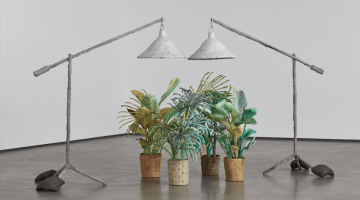As a spectator entering a gallery or museum, anticipation of aesthetic elation is internalized. Once upon these works, viewing an interesting something or other creates a silent, intangible collision of intellect and emotion. The works often unwavering, your opinion and observation, conversely, are fluctuating actions. This existential quandary is the continuative thread through art history from Mesopotamian to Contemporary. Our inquisitive nature relentlessly asks: What is the purpose? What is this function? And, (everyone’s favorite), is this “Art”? Very rarely is the human’s physical presence integral to the function of a work of art. One may argue the mere attendance by the general public to such art viewing arenas, is an act of participation, directly impacting the gravitas of these pieces in question- however, do these works react to you, the spectator? For Joel Dean’s “The Mutant and the Melody,” currently on view at Jancar Jones Gallery, the inanimate becomes animate. Within this space the art and oneself are unified in flux.
Resembling paintings, four panels lean against the walls of Jancar Jones, dozens of tonal rocks strewn across the floor. Size and width of each panel are equal in scale with all the industrial harmony of a McCracken. Dean’s panels are cascades of electric gradients. However, if you are in this intimate space with more than yourself the panels begin to morph with a suddenness that is surprising. This is not clear at first. As you enter, the panels remain glossy and brightly hued. But, what are in fact heat sensitive panels begin to change. As you approach each, the color morphs, unceremonious and instantaneously, to a deep monochromatic shade. The miniature boulders scattered at your feet appear to be of random placement. With tiny aisles giving way to loose, makeshift prosceniums, cleared at the foot of each panel. This, undeniably, begs a viewer to come close and observe, only for the works, to vanish within a fraction of a second. But, before you find yourself in such close proximity to these works, you must navigate through the artificial gravel. As you try your best to avoid these rocks your nerve level spikes. Anxiously treading around the path already created, you look closer (or sneak a squeeze); ironically, the rocks in question are made of the same foam rubber as standard issue stress balls. You can’t help but feel like being a pawn in a diversion.
According to Dean the participatory nature of, “The Mutant and the Melody,” reflects the structure of a narrative fable. You the observer and gallery patron come to a “pithy maxim” of shared human endeavor, through this event made up of these elusive, seemingly disconnected elements. This seemed grandiose at first but once immersed within, the fleeting beauty ahead (panels) and the challenges set before (stress ball rocks), seem to mirror something that is bigger than its existence. Beyond that, those relentless inquisitive humane questions are never answered, making even your “pithy maxim” an unsettled resolve. “The Mutant and the Melody,” is confusingly beautiful constructed with conviction that can only be described complex simplicity.
For more information visit here.
-Contributed by Bianca Guillen







